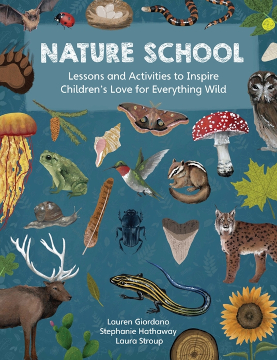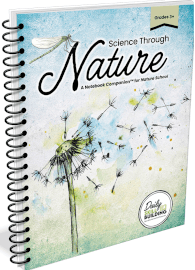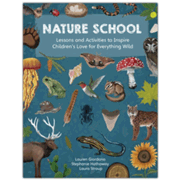The book Nature School, coupled with one or both of the two Science Through Nature Notebook Companions™, makes an outstanding nature study course that can be used for kindergarten through about eighth grade.
Nature School
 Nature School: Lessons and Activities to Inspire Children’s Love for Everything Wild was written by Lauren Giordano, Stephanie Hathaway, and Laura Stroup (published by Quarto Publishing Group.) It serves as an excellent information book for studying animal life, biomes, weather, and much more.
Nature School: Lessons and Activities to Inspire Children’s Love for Everything Wild was written by Lauren Giordano, Stephanie Hathaway, and Laura Stroup (published by Quarto Publishing Group.) It serves as an excellent information book for studying animal life, biomes, weather, and much more.
This 144-page book is beautifully and thoroughly illustrated with just about as many full-color images as there are paragraphs of information. The book includes optional hands-on and outdoor activities.
While the copious illustrations make the book accessible and inviting for younger students, the text is written at a higher level and occasionally includes words such as crepuscular (p. 23) and autotroph (p.35) that even adults might not know. The overall readability level is about sixth grade. While younger children won’t be able to read it on their own, it should work fine as a read-aloud book if parents take time to explain when needed. Keep in mind that it is an information book rather than a narrative, and you will generally read a few pages at a time.
The book is divided into five color-coded sections: Temperate Forests, Deserts, Seashore, Grasslands, and Wetlands. (The color-coding frames each page and makes it easy to find where sections start and stop.) Within each section, students learn about the ecosystem, climate and weather, landforms, types of animals and plants found there, and predators within the system. Students become familiar with these elements and how they interact. The book includes some topics that transcend each system, such as transpiration in plants, the seasons, and the carbon cycle. Additional tidbits of information are added to each section as “Fun Facts” and as a short article under the heading “Did You Know?”
Each of the five sections concludes with four pages of activity suggestions. These always include nature journaling and a nature walk, and the other suggestions are varied to suit different learning styles. For instance, the Desert section, in addition to the nature walk and journaling, suggests growing a cacti garden indoors, creating a desert scape diorama, sculpting a cactus from clay, doing an evaporation demonstration, making a sundial, and exploring and discussing deserts on a world map.
While the book mentions adaptations, it does not have any explicit evolutionary content and should work well no matter the family's beliefs about evolution.
Science Through Nature Notebook Companions™
 Two Science Through Nature Notebook Companions™ by Carrie Fernandez and WriteBonnieRose (published by Daily Skill Building) supply what’s needed to use Nature School as the spine for a 30-week nature study course. They do so by presenting questions and activities at two different levels in the regular Notebook Companion for third grade and up and the Junior Notebook Companion for kindergarten through third grade. (You might also use the regular Notebook Companion for high school, but it needs supplementing with more rigorous work and lab activities at that level.)
Two Science Through Nature Notebook Companions™ by Carrie Fernandez and WriteBonnieRose (published by Daily Skill Building) supply what’s needed to use Nature School as the spine for a 30-week nature study course. They do so by presenting questions and activities at two different levels in the regular Notebook Companion for third grade and up and the Junior Notebook Companion for kindergarten through third grade. (You might also use the regular Notebook Companion for high school, but it needs supplementing with more rigorous work and lab activities at that level.)
Both notebooks are spiral bound with about 300 black-and-white pages. They present questions based on Nature School, adding lines for students to write their answers. (Young children might dictate their answers.) Older students have more questions and require more detail. For example, at the beginning of the Grasslands section in the Notebook Companions, younger children are asked specific questions such as, “How many kinds of grass are there?” and “What do we call the leaves of a grass plant?” Meanwhile, older students answer questions like, “What family do grasses belong to? How many species of grass are there?” and “Summarize what you learned about grasses.” Older students must process, analyze, and summarize information while younger students answer mostly comprehension questions.
Activity pages to be used for the activities described at the end of each section in Nature School are found at the back of each notebook. They have headings for each activity but are otherwise identical. Students can draw and write about the activities in a manner suitable for their age. For example, older students might record and analyze observations while younger children tell what they saw.
The Junior Notebook Companion has a few pages with images to color or label, and the upper-level notebook has even fewer. Both notebooks have many framed boxes in which students are to draw, but older students complete many more drawings and supply more details. Older students also have boxes where they are to record the Fun Facts scattered through each section plus a space where they are to summarize what they learned from each section’s Did You Know? sidebar.
There are no answer keys, so parents who want to check student work must refer to Nature School. It’s up to parents to convey their expectations for the level of work, such as whether answers must be written in complete sentences, how much detail should be included on drawings, and how completely older students’ summaries need to convey what’s covered in the book.
Add-ons
Daily Skill Building offers several inexpensive add-on (or substitute) items for the Science Through Nature Notebook Companions that you need to know about. All of these are available only as PDFs.
Lesson Plans
Separate lesson plans for both levels come free with the purchase of either Notebook Companion, along with a second option for each level that includes scheduling for the items below. Lesson plans are for a 30-week schedule, five days a week. The amount of time required per day varies, and some days are left unscheduled for catching up. The schedules should be very manageable, and some families might move through the course in fewer than 30 weeks.
The lesson plans should be very helpful for scheduling the activities since they are bunched together at the end of each section of Nature School. The lesson plans stagger them at appropriate times, breaking up the reading and writing with other activities. Perhaps more importantly, the lesson plans also let parents know the amount of content to cover in the books each day.
Science Through Nature: Coloring & Notebooking
The publisher created these 359-page sets of Coloring & Notebooking pages as an add-on rather than a substitute for the notebooks. Both sets have blackline illustrations to color plus lines for writing, with lines spaced farther apart for the junior level. These pages are scheduled in the second option lesson plans for both levels.
My recommendation is that you use the junior set of Coloring & Notebooking pages with kindergartners and first graders rather than the Junior Notebook Companion.
Those who prefer more of a Charlotte Mason approach might consider substituting a set of Coloring & Notebooking pages for a Notebook Companion, even for students beyond first grade. Students can color and write or dictate their own narrations about what they have learned.
Science Through Nature: Cut & Paste Life Cycle Worksheets
The 190-page Cut & Paste Life Cycle Worksheets set might be used with all ages but is intended for those using the Junior Notebook Companion since the regular Notebook Companion already asks students to draw life cycles in several of the framed boxes. You can use either black-and-white or color pages. For these worksheets, students cut out the images for each stage of a life cycle and then paste them on a labeled graphic organizer. They can color images if they want. The use of these pages is scheduled into the optional lesson plans for the Junior level.
Fact Cards
The Fact Cards (which includes files for both black-and-white and color), provide you with animal and plant fact cards for each of the five sections of Nature School in two formats. Cards are printed four per page with images on one side and information on the reverse. Half of the cards have preprinted information and half have lines for students to write in the scientific name, size, main colors, and interesting facts. The Fact Cards are scheduled into the second option lesson plans for the regular Notebook Companion.
Summary
The combination of Nature School and the Notebook Companion books should work well for homeschoolers, requiring no prep work by parents other than for activities. I suspect that there’s too much detail for most young children, so I would personally start using the Junior Notebook Companion with third and fourth graders and use the upper level with fourth or fifth grade through eighth grade.








